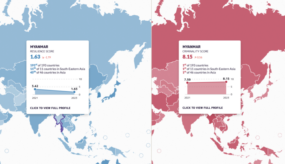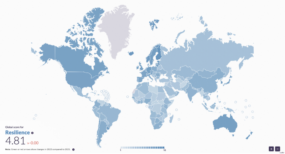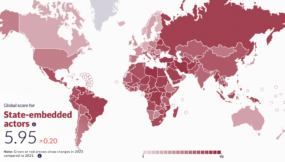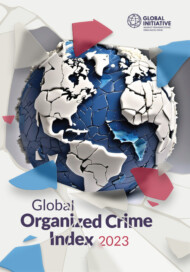Posted on 21 Aug 2024
The Global Organized Crime Index 2023 paints a bleak picture: criminality is increasing but resilience to it is not. Building resilience to organized crime needs more than a robust criminal justice infrastructure. It requires a host of incremental changes to reshape the landscapes that provide fertile ground for organized crime. Until that happens, parts of the world will continue to make way for criminal enterprise. In such places, where organized crime operates not in the shadows but in plain sight on an industrial scale, the demand for a criminal labour force is insatiable. Those who supply this demand exist in a grey zone that makes it hard to discern who is a victim, who is a perpetrator, and who may in fact be both.
A spectrum of victims and perpetrators
The Index provides insight into the categories of criminals involved in organized crime – foreign and domestic groups, networks, the private sector and state-embedded actors. The convergence of criminal markets and the complexity of criminal profiles are starkly evident in financial crimes. Scams linked to investment opportunities, employment, e-commerce and romance are now widespread global phenomena in places ranging from Mexico and Peru to Georgia, Israel, Cambodia and Ukraine.
Take Myanmar, the country with the highest criminality score in the world (8.15 out of 10), according to the Index rankings. This is partly due to the 2021 coup, which entrenched crime and shattered the country’s already fragile resilience architecture. In Myanmar and elsewhere in the Mekong region, the labour force recruited to commit financial crimes in casinos and purpose-built scamming centres is made up of hundreds of thousands of people from the region and beyond. Many have been described as victims of trafficking in persons for the purpose of forced criminality. The principle that people should not be punished for the crimes they have been trafficked to commit is well grounded, but insufficiently upheld in some countries.
Crime hubs emerge where state frameworks to identify and refer victims for protection are fractured and where socio-economic, geographical, political and socio-political vulnerabilities can be instrumentalized and commodified. In such contexts (which the Index locates in the ‘high criminality–low resilience’ quadrant), questions arise about the pursuit of perpetrators: how wide should the net of criminality be cast? What does criminal intent look like in places where organized crime interests build infrastructure, stimulate local economies and create opportunities where none existed before? What does it mean to make a living from organized crime in operations that have achieved a veneer of legitimacy and state sanction?
Behind that veneer are desperate people whose vulnerability has been taken advantage of to trap them in criminality, or people who have been deceived by false promises, threatened and even tortured into committing crimes that yield significant profits for criminal employers. In such situations, what are the limits of liability?
Victim and witness protection as an indicator of resilience
The Index measures ‘victim and witness support’ as one of several other indicators of state resilience to organized crime. Globally, this indicator scores an average of 4.24, suggesting that there are ‘failings in prioritizing the very systems designed to protect those most at risk of the harms of organized crime’. Supporting victims and witnesses means first identifying them, but the overlapping identities and complex experiences of people involved in crime mean that it is not always possible to draw a clear line between those who should be referred for protection and those who should be prosecuted. Where a perpetrator of a crime (such as fraud, cybercrime, extortion or drug trafficking) is the victim of another (such as human trafficking), how can justice be upheld for both the victims of forced criminality and those who are victimized by them?
The UN Office on Drugs and Crime notes that systems for identifying victims of organized crime are ineffective where they are based on inadequate or inaccurate profiles. Victims and perpetrators, according to them, ‘are not mutually exclusive categories as people shift between them or are both simultaneously’. As an example, the UNODC cites the plight of a teenager recruited into an organized crime group or gang who is both a perpetrator and a victim of violence. For such victim-perpetrators, the risk of being again victimized by the criminal justice system is acute.
The term ‘victim-centred’, widely used in criminal justice conversations, is not a soft concept, but an extremely difficult one to implement in the real world, where there are no ‘perfect’ victims and where concepts of good and evil are so blurred. It is uncomfortable to raise the question of how to protect victims of crime who are simultaneously dangerous offenders. The screening tools used to identify victims need to interact with the investigative techniques used to identify perpetrators, so that nuanced conclusions can be drawn beyond simplistic dichotomies.
Building resilience by protecting perpetrators
The primary purpose of victim and witness support is, of course, to uphold the rights of victims and witnesses. The secondary, more strategic purpose is to cultivate allies against organized crime. The pursuit of this prevention objective may require the protection net to be cast wider than it currently reaches, to include not only people who have been victimized by organized crime, but also those who have been victimized as perpetrators.
Protection is integral to prevent organized crime when it empowers victims as witnesses. Considerable efforts are being made to prevent vulnerability to victimization. The next frontier is to understand how perpetrators are created and, on that basis, to determine how to punish them as offenders and protect them as victim-witnesses. In some cases, prevention objectives will be better served by protecting them than by punishing them. In others, the opposite may be true. In all cases where the interests of justice must be weighed, human rights considerations are critical.
Failure to recognize and protect victims among offenders can lead to revictimization and human rights violations caused by the criminal justice system that should have protected them. But there is more at stake from a prevention perspective. The Index notes that witness protection programmes are ‘often the only way to successfully prosecute organized criminals.’ States should be held accountable for failing to protect victims and for punishing offenders for unlawful activities they were compelled to participate in. These failures are missed opportunities to prosecute criminals at a higher level.
This analysis is part of the GI-TOC’s series of articles delving into the results of the Global Organized Crime Index. The series explores the Index’s findings and their effects on policymaking, anti-organized crime measures and analyses from a thematic or regional perspective.



